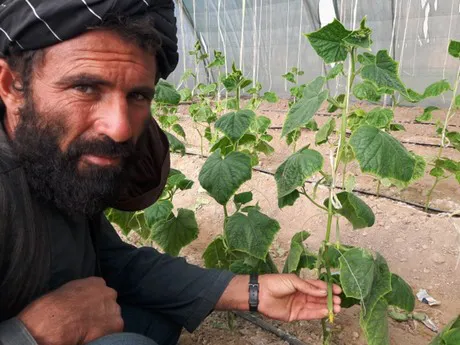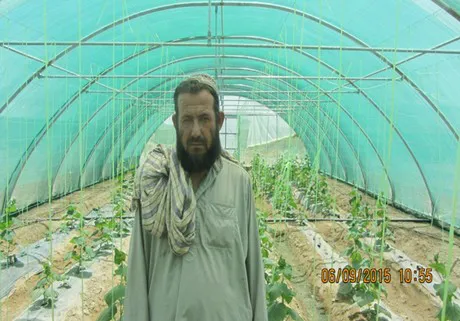"Winters in Afghanistan can be harsh for farming", as a USAID spokesperson explains to us. "Greenhouses reduce food insecurity by allowing for early maturity and extending the growing season of vegetables. Greenhouses also decrease the loss of irrigation and increase land use efficiency."
As part of the Kandahar Food Zone program (KFZ), the main objective of which is to transition farmers out of poppy production and into economically viable licit alternative sources of income, USAID pushes off-season vegetable production in greenhouses.
"Through our implementing partners and the Afghanistan Ministry of Agriculture, Irrigation, and Livestock (MAIL), USAID has supplied and refurbished a large number of greenhouses over the past 10 years. Along with the supply or refurbishment of greenhouses, we also include technical training on effective use, maintenance, and management techniques-cultivation, irrigation, disease control, and harvesting."
According to the latest figures, 47 greenhouses have been established under the program, in which 38 produce off-season vegetables. Also, low tunnels have been installed in 100 household compounds, and trained farm women were trained in off-season vegetable cultivation and post-harvest management of fruits and vegetables.
"Low tech greenhouses are best utilized in Afghanistan," the USAID spokesperson continues. These include drip irrigation, high and low tunnels - which utilize plastic covers over a framed structure, and plastic row covers.
Fresh cucumbers in winter
One of the growers who has benefited from the KFZ program is Baacha Khan. Poppy and marijuana were the sole source of income for him to feed his family.

In June 2015, KFZ established a greenhouse for Baacha Khan and provided technical greenhouse training to him.
Prior to KFZ intervention, Baacha Khan did not know much about modern agriculture procedures. Pretty soon though, he had his third harvest from the greenhouse. With the income, Khan can support his family and save money to establish another greenhouse.
“I clearly remember that my family was suffering from low economy and my children were yearning for fresh cucumbers in winter season", Khan says. "Now, I not only can produce fresh vegetables for my family but also sell them in the closest neighbors and local markets."
Kandahar
Lack of a reliable and suitable irrigation water supply and innovative agricultural practices resulted in reduction of agriculture production in the province of Kandahar, compelling farmers to shift their fields and moved to other cities. After the rehabilitation of irrigation canals and alternative livelihood activities by USAID’s KFZ program, the agricultural outcome is increasing and the farmers are returning back to their farmlands.

Ramazan is one of the 11 beneficiaries in the Takhta Pul district greenhouse establishment and training project. KFZ built the Takhta Pul greenhouse in June 2015. The aim of the greenhouse project is to support alternative livelihoods through creating sustainable income opportunities, introducing new technologies and latest agriculture practices, thereby making licit crops more profitable and decrease poppy cultivation.
Ramazan, along with ten other farmers have been trained in the project. He moved to Kandahar City due to low income from farming in the Takhta Pul district and left his farmland barren for many years. After the training, Ramazan returned back to his village in order to utilize their farmland according to the new agricultural practices he learned.
"The training was an altering experience in my life", Ramazan says. "It brings me back to my field and my village after a long period. I expect to expand my greenhouse business and supply fresh vegetable to the market at different seasons."
Baacha Khan and Ramazan are just two successful examples of growers who have benefited from greenhouse technology. We can only hope there will be many more to shake off poverty and experience growth thanks to the rise of greenhouse cultivation in Afghanistan.
For more information:
 USAID
USAIDwww.usaid.gov
